There’s no airport here, no wi-fi, not a latte to be found anywhere, and the only way to tweet or update your Facebook status is by mustering the patience to deal with the 90s-style dial-up connection available.
Stepping back in time is a big part of travelling to Tristan. Teenage dances are held in the hall on Saturday nights, there are just two channels to choose from on TV, and the hospitality on offer has long since disappeared in many parts of the world. And then there’s the transport. Some islanders do have cars and there’s even an intermittent bus service, but only a fraction of the 98-square-kilometre lump of volcanic rock is accessible by anything other than a rugged hike. The challenge lies not in getting around the island but in getting there in the first place.
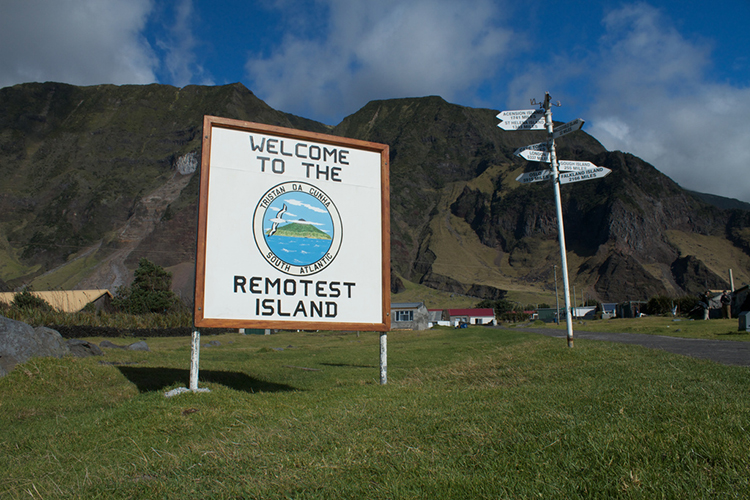
Tristan sign by Brian Gratwicke. CC BY 2.0.
Tristan is British territory, but the gateway to the island sits a mere 2800km away in South Africa. Vessels depart from Cape Town to make the often arduous six-day crossing to what is ‘the world’s remotest inhabited island’, according to the local tourist board and no less an authority than the Guinness Book of World Records. Boats making the trip vary – in the summer months, a couple of cruise ships pass by as they travel from Africa to Latin America and the spiffy new SA Agulhas II research vessel visits each September.
But for the rest, a rough-and-ready voyage awaits. Eight times a year, cargo and fishing boats leave Cape Town’s gleaming harbour to tackle the rolling waves to Tristan. On board amenities are few – a sole bathroom shared by the half-dozen passenger cabins, a TV room where surprisingly varied meals are served, a couple of chairs on the deck and plenty of banter with the crew heading off to the crayfish-rich waters around Tristan.
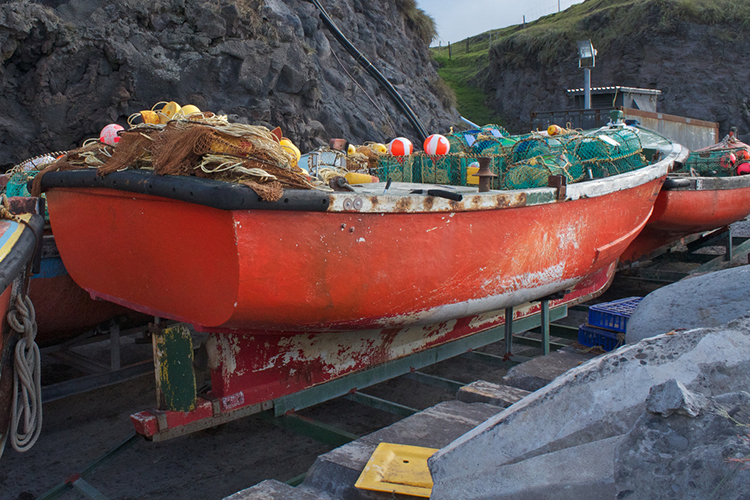
Lobster long boat on Tristan by Brian Gratwicke. CC BY 2.0.
Days are long and for those yet to find their sea legs, it can be tough. Nausea can make everything bar lying around on your bunk a rather miserable mission, at least for the first couple of days, so be sure to bring audio books alongside the visual kind. Seasickness remedies are a must, for even the staunchest of sailors have been known to get queasy on the journey. But this voyage brings plenty of bright moments too. Albatross follow in the boat’s wake, the pleasure of seeing nothing but ocean in every direction offers a sense of solitude rare in today’s uber-connected world and if you’re lucky, there will be a few Tristanians on board to fill you in on what life is like on a rock in the middle of nowhere.
Tristan was first sighted in 1506 by Portuguese mariner Tristao Da Cunha but it wasn’t settled until 1816 when the British took possession, largely with the purpose of keeping an eye on Napoleon, in exile on ‘neighbouring’ St Helena (2400km away). A few of the British military men stayed behind and over next 92 years, a handful of settlers arrived, including shipwrecked sailors from Italy, the UK and the Netherlands, American whalers looking for a slice of the quiet life and a handful of women from St Helena on what must have been one of the world’s earliest long-distance blind dates. Today, just 259 people descended from the original settlers call the island home, making a living from crayfishing, the sale of sought-after stamps and a tiny tourism industry.
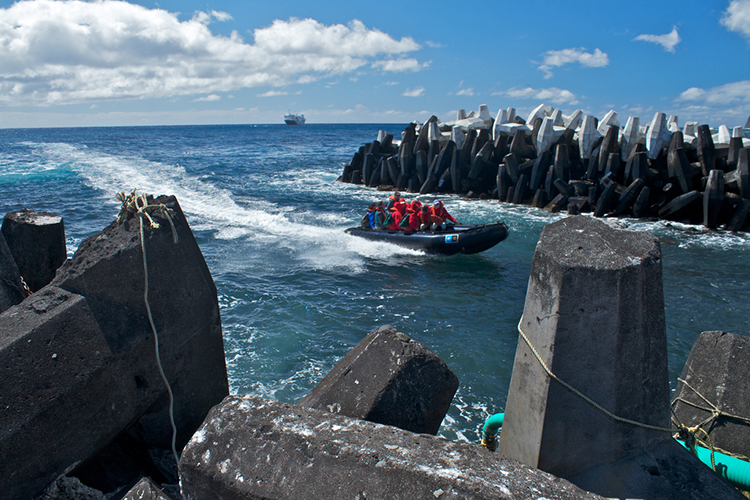
Zodiac arriving at Tristan by Brian Gratwicke. CC BY 2.0.
Arriving is as eventful as travelling here: visiting boats cannot dock in the island’s diminutive harbour, so you’re left with the choice to climb down a rope ladder into a waiting dinghy bobbing wildly in the waves or to be hauled off (and later back on again) in a metal cage dangling from a crane.
So what exactly is there to do on the island? Well, don’t come expecting art galleries, nightlife or even a string of restaurants. There is a sole pub, The Albatross, open for just a few hours a day and a shop selling everything from basic supplies to homemade crisps (Tristanians are rightly proud of their potato crop) and hand-knitted Tristan beanies. One thing you won’t find much of in the shop is crayfish or meat, two commodities quite readily available on the island and ones you’re likely to be gifted by locals if you stick around for more than a couple of days. If you’re particularly lucky, you’ll get to try stuffed mutton – a deboned leg of lamb filled with potatoes and seasoning, usually reserved for Christmas feasts.
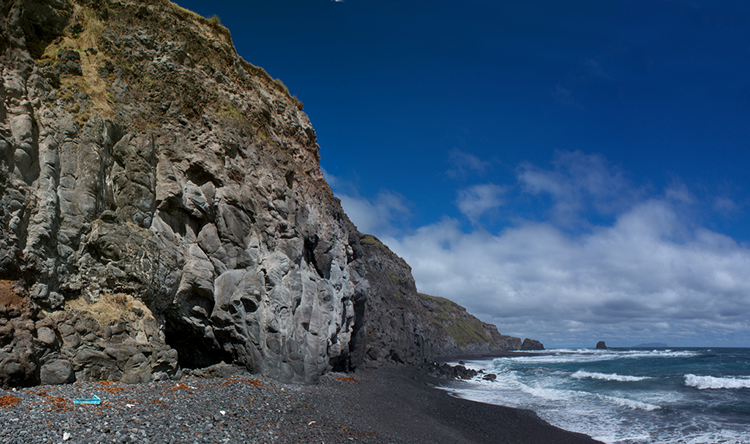
Pillow basalt cliffs by Brian Gratwicke. CC BY 2.0.
Food on Tristan is hearty, but outdoor pursuits are plentiful. Hiking routes up the imposing 2062m-high volcano are vertiginous and rarely marked, making a guide an essential, especially if you hope to reach the peak. Gentler walks visit the Potato Patches (where the island’s crops are grown) or the site of the 1961 volcanic eruption. You can also play nine holes on what is probably the most rugged golf course you’ll ever see – a course where cows and their poo provide extra hazards and chickens routinely chase after golf balls.
In the end, of course, Tristan’s main attraction is its solitude. Walk the lanes of Edinburgh of the Seven Seas (referred to locally as simply ‘The Settlement’), seek out the resident rockhopper penguins with their striking carnival-like plumage, or sit and chat with affable locals over tea and cake in the tourism office-cum-museum-cum-café. The journey to get here might be a little gruelling, but then no one ever said that time travel would be easy.
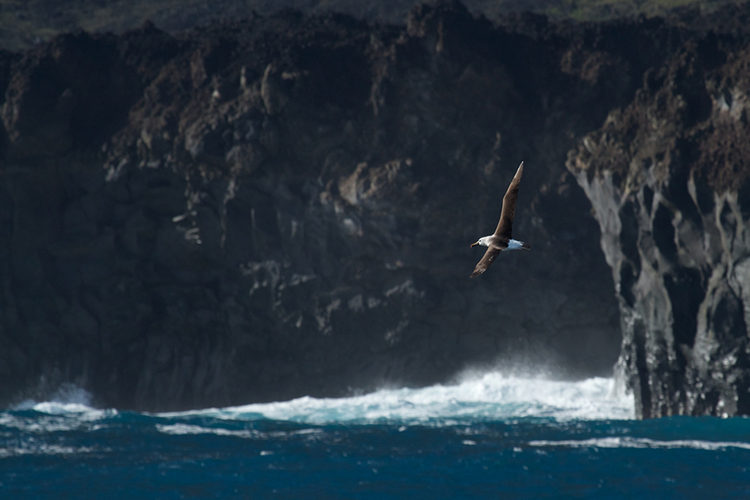
Yellow-nosed albatross by Brian Gratwicke. CC BY 2.0.